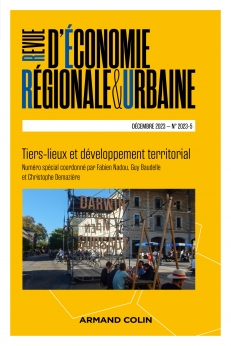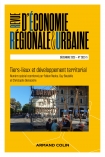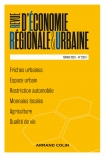
REVUE D'ÉCONOMIE RÉGIONALE ET URBAINE (5/2023)
Pour acheter ce numéro, contactez-nous
Recevez les numéros de l'année en cours et accédez à l'intégralité des articles en ligne.
L’émergence des tiers-lieux (TL) est un phénomène rapide et récent bien que le concept soit né aux États-Unis il y a plus de trente ans. Il s’inscrit dans un processus historique long d’apparition de système productifs localisés (SPL), soit d’inspiration italienne avec les districts industriels (DI), soit d’inspiration américaine sur le modèle des clusters. Ces structures nées des années 1970-1980 constituent un premier tournant territorial. L’avènement des TL en grand nombre porte des enjeux forts et fait suite au cumul de plusieurs facteurs à dimension mondiale (accélération de la crise climatique, crise financière de 2008, crise sanitaire depuis 2019). Ces évènements inaugurent, après une période d’approfondissement de la mondialisation, un deuxième tournant territorial. Le premier tournant a été dominé par la forme DI ou SPL, le deuxième semble s’inaugurer autour d’une forme voisine mais pas identique d’intégration systémique, production et consommation, de type TL. Celui-ci serait l’avatar le plus récent du développement territorial. L’article montre que l’industrie wallonne, très tributaire du modèle fordiste en déclin, n’a pas vraiment pris le premier virage mais, avec la réalisation du plan Creative Wallonia, s’engage depuis une dizaine d’années dans ce deuxième tournant environnemental et sociétal.
The emergence of Third Places is a rapid and recent phenomenon although the concept was born in the United States more than thirty years ago. It is part of a long historical process of appearance of localized production systems either of Italian inspiration (Industrial districts) or of American inspiration (with the model of clusters). These structures, born in the 1970s and 1980s, constitute a first territorial turning point. The emergence of Third Places in large numbers, carries strong stakes and follows the cumulation of several factors with a global dimension (acceleration of the climate crisis, financial crisis of 2008, health crisis since 2019). These events inaugurate, after a period of deepening globalisation, a second territorial turning point. The first turning point was dominated by the "industrial district" or "local productive system" form, the second one seems to be inaugurated around a similar but not identical form of systemic integration, production and consumption, of the "Third Places" type, which appears as the most recent “avatar” of territorial development. The article shows that the Walloon industry, very dependent on the declining Fordist model, has not really taken the first but with the realization of the framework program « Creative Wallonia » program is now engaged in this second environmental and societal turning point.

